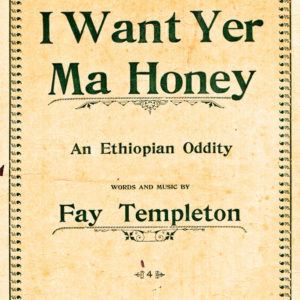calsfoundation@cals.org
Fay Templeton (1865–1939)
Born into a theatrical family, Fay Templeton excelled on the legitimate and vaudeville stages for more than half a century. As an actress, singer, and comedian, she was a favorite headliner and heroine of popular theater.
Fay Templeton was born on December 25, 1865, in Little Rock (Pulaski County), where her parents were starring with the Templeton Opera Company. John Templeton, Fay’s father, was a well-known Southern manager, comedian, and author. Helen Alice Vane, Fay’s mother, starred with her husband. At age three, Templeton, dressed as Cupid, sang fairy tale songs between the acts of her father’s plays. Gradually, she was incorporated into the productions as a bit player and then, at five, had actual lines to recite. At eight, she played Puck in A Midsummer Night’s Dream at New York’s Grand Opera House. She sang a contemporary tune, “Up in a Balloon,” and created a sensation.
At fifteen, Templeton was an accomplished light opera singer. She played in several juvenile versions of Gilbert and Sullivan productions, often as the leading singer. The same year, she eloped with Billy West, a blackface minstrel performer, but they separated after a honeymoon of six weeks.
On October 7, 1885, Templeton had her formal debut in a revival of Evangeline. The play ran for 201 performances. In this show, she displayed talent as both a comedian and mimic.
After several years on the road playing in various melodramas and musical farces, Templeton was given the title role in Hendrik Hudson, which opened at the 14th Street Theater on August 18, 1890. It was a “trouser role,” one in which an actress appears in male clothing, then a popular feature of operettas. Her role was of a faithless husband. She won accolades singing “The Same Old Thing,” but the show itself lasted only sixteen performances.
Between shows, in 1887, Templeton began living with Charles J. Osborne, a wealthy broker for Jay Gould; there is no record that they ever married, and the two had no children. The two lived in England and toured the continent for several years. She starred in Monte Cristo, Jr., an 1886 hit that ran for two seasons.
By 1890, Templeton had formed her own opera company and starred in various operettas, none of which fared well financially. In 1895, she starred in another trouser role in E. E. Rice’s Excelsior, Jr. at Oscar Hammerstein’s new Olympic Theater.
In 1896, the comic duo Joe Weber and Lew Fields bought a Broadway theater and formed a stock company made up of headliners, including Templeton. Although she was now buxom even by Gay Nineties standards, her comedic versatility, long dark hair, sultry smile, and throaty-voiced singing won over audiences. She enjoyed the Webserfieldsian productions and believed her time at the Music Hall to be one of the best of her career. In a 1900 show, she introduced John Stromberg’s “Ma Blushin’ Rosie, Ma Posie Sweet,” which became the hit of the show. In 1901, she introduced “I’m a Respectable Working Girl” in the new Music Hall show; she did encore performances several times each evening.
After Weber and Fields split, George M. Cohan hired Templeton to play the lead in Forty-Five Minutes from Broadway. Fay introduced the hit songs “So Long Mary” and “Mary Is a Grand Old Name.” A few months later, she married a Pittsburgh industrialist William Patterson and announced her retirement from the stage; she and Patterson also had no children.
In 1911, Weber and Fields began planning their reunion with a Jubilee touring company featuring all the old Music Hall stars. Templeton was one of the first to volunteer. The tour lasted five months and broke all records for touring companies. She continued in vaudeville with an act that included songs from previous shows. In 1913, Templeton again announced her retirement.
In 1925, she appeared in an old-timer’s show at the Palace Theater, working with Weber and Fields. Asked if she would continue to perform, she replied, “It’s been great fun, but it’s a new Broadway and a new theater, and hereafter I’ll be content to look on from out front.” But she returned to the stage again in 1926 to play Buttercup in a revival of Pinafore. Again, she claimed it was her last appearance on stage.
When Templeton’s husband died suddenly in 1932, she returned to the stage to earn a living, appearing in Jerome Kern’s Roberta as Aunt Minnie, a dress shop owner in Paris. Bob Hope, in his stage debut, handled the comedy. She had only one song, “Yesterday.” The show ran for nine months.
At age seventy-one and suffering from arthritis, Templeton found herself out of funds and entered the Actors’ Fund Home in New Jersey. On October 3, 1939, she died in San Francisco, where she had moved to live with a cousin. She is buried in Kensico Cemetery in Valhalla, New York; few attended her funeral.
For additional information:
Cullen, Frank, Florence Hackman, and Donald McNeilly. Vaudeville, Old & New: An Encyclopedia of Variety Performers in America. 2 vols. New York: Routledge Press, 2006.
Fields, Armond. Women Vaudeville Stars: Eighty Biographical Profiles. Jefferson, NC: McFarland & Company, 2006.
Slide, Anthony. The Vaudevillians. Westport, CT: Arlington House, 1981.
Armond Fields
Culver City, California
 Arts, Culture, and Entertainment
Arts, Culture, and Entertainment Post-Reconstruction through the Gilded Age, 1875 through 1900
Post-Reconstruction through the Gilded Age, 1875 through 1900 Fay Templeton
Fay Templeton  Fay Templeton Sheet Music
Fay Templeton Sheet Music 




Comments
No comments on this entry yet.